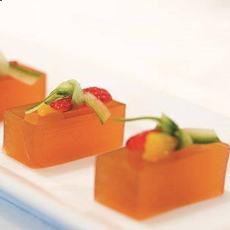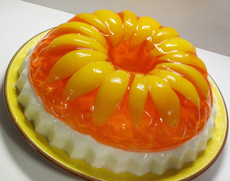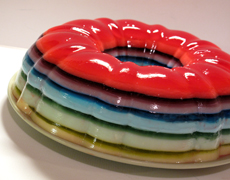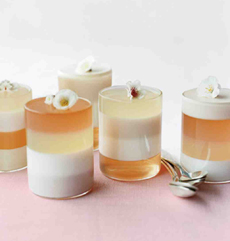TIP OF THE DAY: Rethink Jell-O As Elegant Gélee
|
|
Check online and you’ll find that more people are horrified by retro Jell-o molds than embrace them.
Yet, these gelatin works of art, that became de rigeur party fare in the 1950s, get a bad rap. Seriously, what’s wrong with different flavors of Jell-O and fruit layered in an attractive mold? They are very tasty, thank you, and enable the cook to exercise creativity. If the media mentioned, say, that they were a favorite at the Kardashian or Brangelina household, molds and Jell-O would be flying off the shelves. Sugar-free Diet Jell-O provides a low-calorie dessert option. And a holiday offers the opportunity to use theme colors. Maybe ditch the brand name, Jell-O, and the generic term, gelatin, when presenting the dish. Call it something that sounds like a sophisticated dessert. We prefer the French name for a gelatin dish, gelée (zhel-LAY) or gélatine (zhay-la-TEEN), which identifies the product, gelatin. Trivia: The name comes from the Latin gelare, to freeze. Make this harvest-colored Ginger Gelée with the taste of fall. The recipe was adapted from TheSugarMonkey.com. |
|
|
As you can see in the photo below, you don’t need to make the dish in a mold. Make the gelée in a baking pan and cut it into elegant rectangles. Or make a layered gelée in glasses, as Martha Stewart did in the second photo below. Ingredients |
||
|
Preparation
1. FILL a small bowl halfway with ice cubes and water. Put the ginger in a small pot of water and bring to a boil. Drain and transfer the ginger to the ice-water bath; let cool. Repeat this process two more times, starting with cold water in the pot each time. 2. SOFTEN the gelatin sheets in a small bowl of cold water. Lift the gelatin out of the water and squeeze it gently to remove the excess moisture. 3. BRING the blanched ginger, water, sugar and vanilla bean pod and seeds to a boil in a medium pot over medium heat. Boil for 5 minutes. Remove the pot from the heat, add the softened gelatin and stir until the gelatin has melted. Strain the mixture through a fine-mesh sieve in a large bowl; discard the ginger and vanilla bean pod. 4. COOL the liquid to room temperature, then whisk in the lime juice. Adjust the color as you like with food color (1 drop red + 2 drops yellow = orange, or see this chart). Pour the liquid into a 1-quart mold or an 8- by 8-inch baking pan and refrigerate until set. Gelatin (also spelled gelatine) has been made since ancient times by boiling animal and fish bones. Aspic, a savory*, gelatin-like dish made from meat or fish stock, was a French specialty centuries before the invention of commercial gelatin. It was very difficult to prepare and thus a dish for the wealthy, requiring days to boil down and clarify natural gelatin to make the aspic set. The aspic was shaped in an elaborate mold, to be admired by the guests. |

TOP PHOTO: Gelée cut into elegant rectangles. Photo courtesy Elegant Affairs. BOTTOM PHOTO: Gelée in glasses. Photo courtesy MarthaStewart.com. |
|
|
Powdered gelatin was invented in 1682 by Denis Papin. The concept of cooking it with sugar to make dessert dates to 1845 and an American inventor named Peter Cooper. Cooper patented a product that was set with gelatin, but it didn’t take off. In 1897, Pearle Wait, a carpenter in Le Roy, New York (in Genesee County), experimented with gelatin and developed a fruit flavored dessert which his wife, May, named Jell-O. The first four flavors were orange, lemon, strawberry and raspberry. He tried to market his product but lacked the capital and experience. In 1899 he sold his formula to a fellow townsman and manufacturer of proprietary medicines, Orator Frank Woodward, for $450. The Jell-O was manufactured by Andrew Samuel Nico of Lyons, New York. Alas, sales were slow and one day, Woodward sold Sam Nico the business for $35. In 1900, the Genesee Pure Food Company promoted Jell-O in a successful advertising campaign, and by 1902 sales were $250,000—more than $6 billion in today’s dollars. In 1923 management created the Jell-O Company, Inc., replacing the Genesee Pure Foods Company, the purpose of which was to protect the Jell-O trade name and to keep it from becoming a generic term. That same year, the Jell-O Company was sold to the Postum Cereal Company, the first subsidiary of a large merger that would eventually become General Foods Corporation. The next flavor, Lime Jell-O was introduced in 1930. Recipes printed on the boxes—including molds—brought more users into the fold. Today Jell-O is manufactured by Kraft Foods, a subsidiary of Phillip Morris, which also acquired both Kraft and General Foods in the 1980s and ultimately merged the two companies. Today there are 21 flavors of regular Jell-O and eight sugar-free flavors, plus puddings and snacks in both categories. There is a Jell-O Museum in Le Roy, New York. |
||





